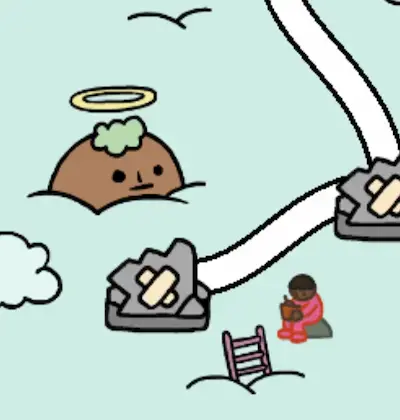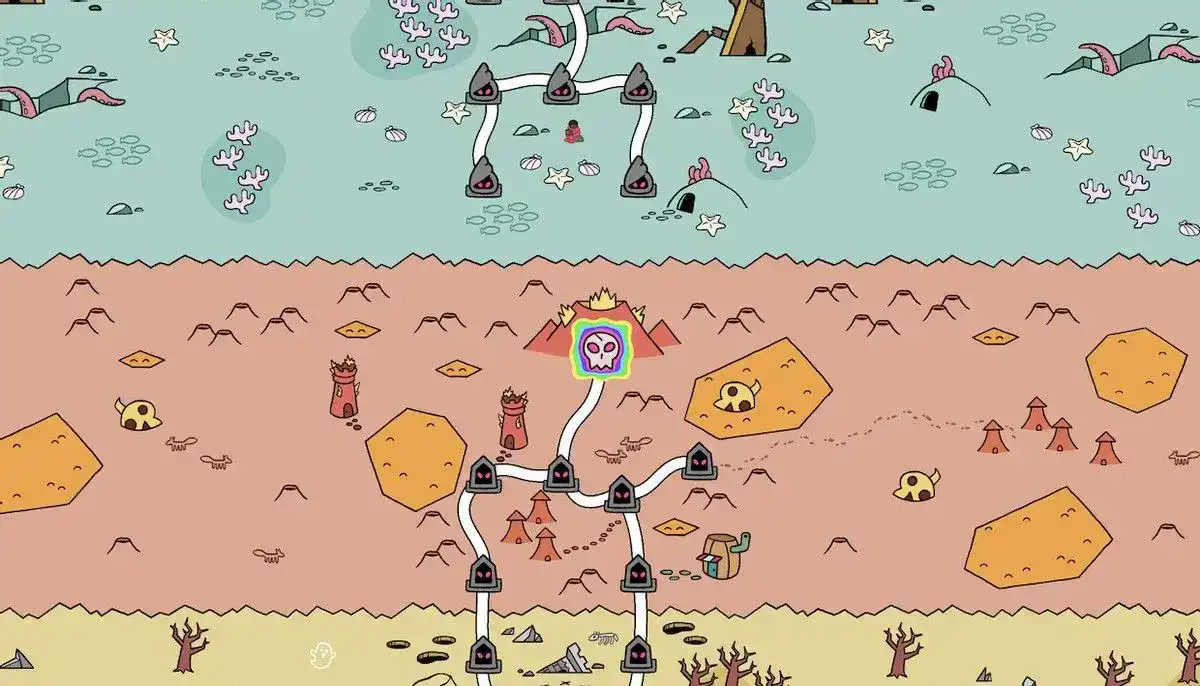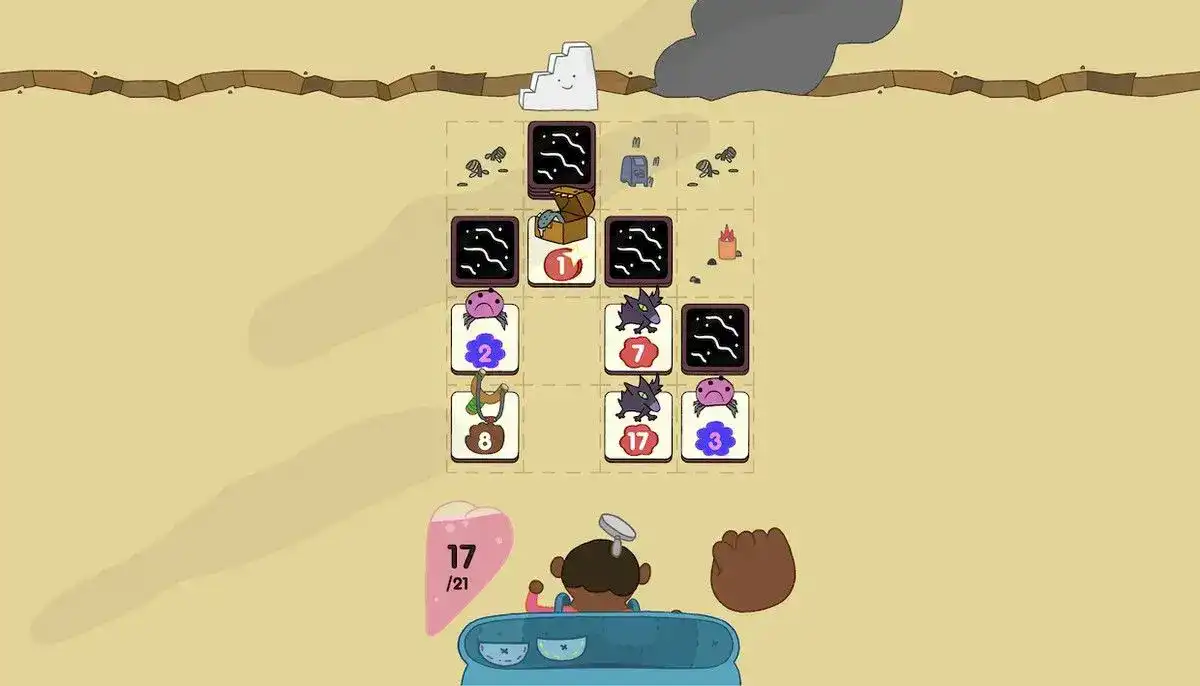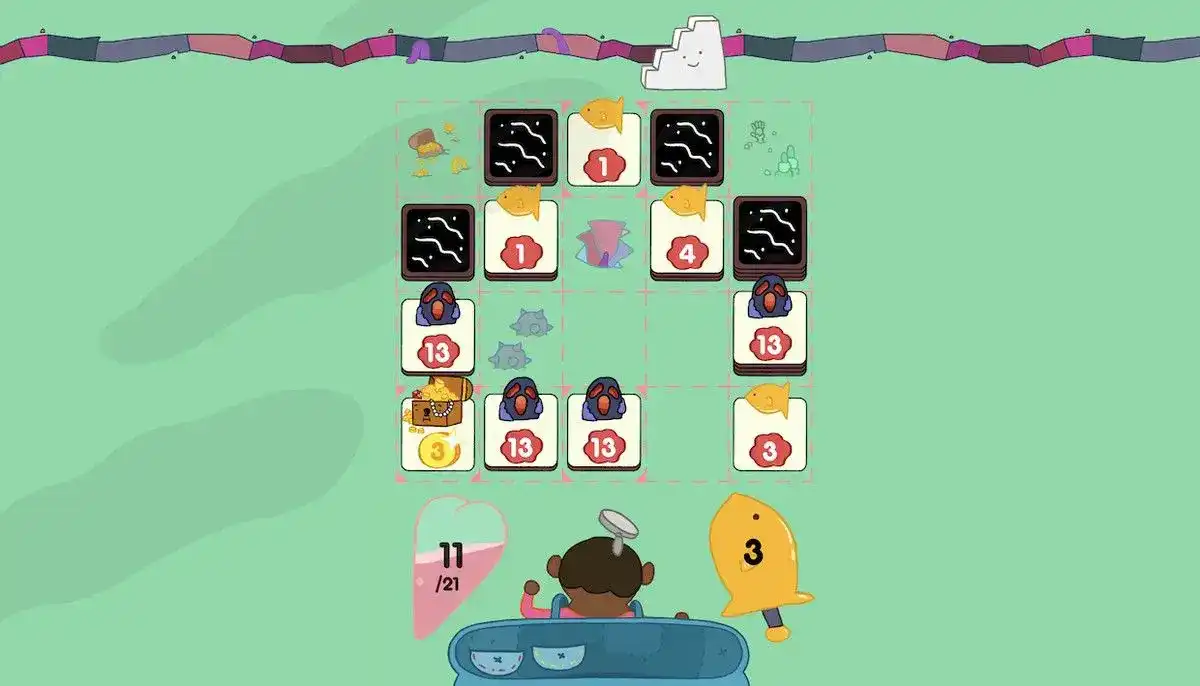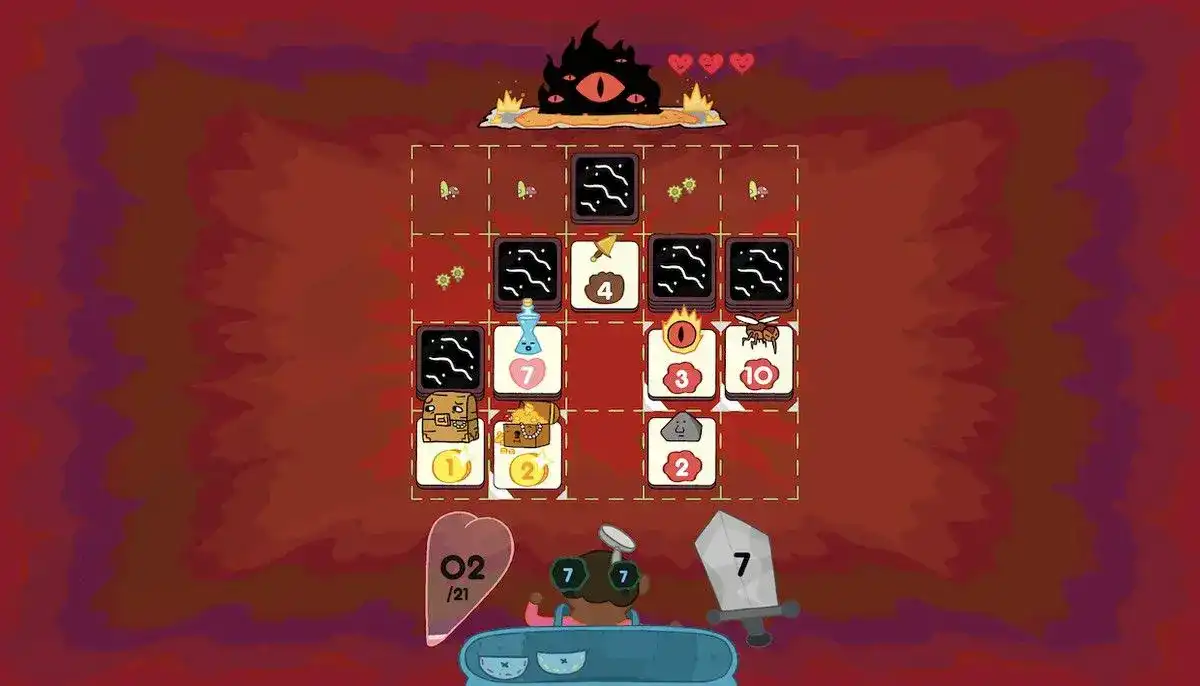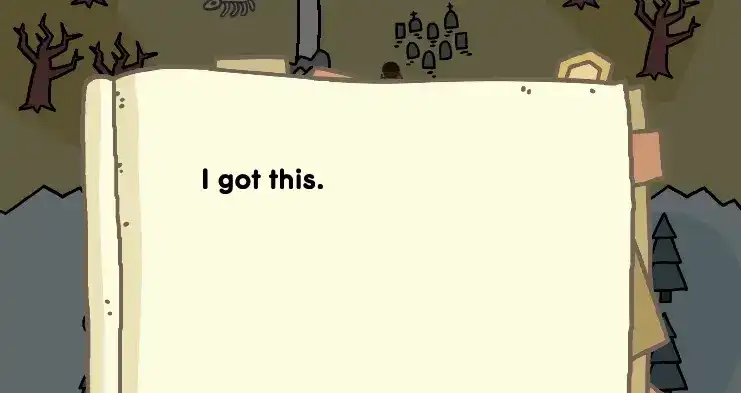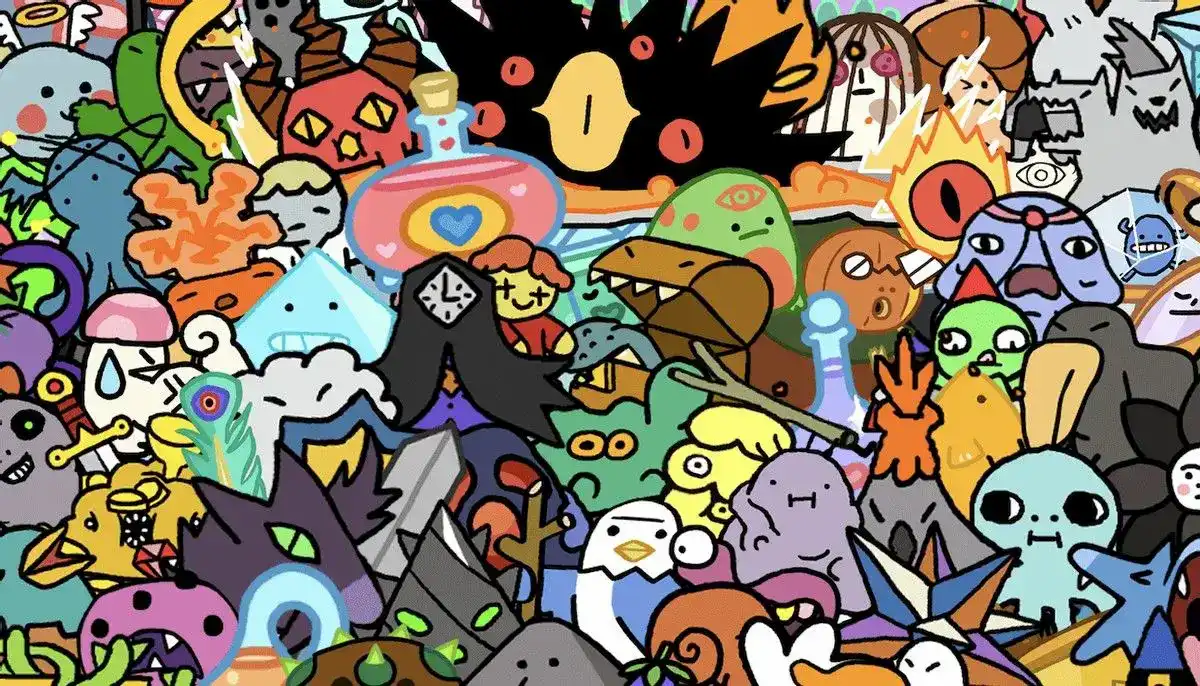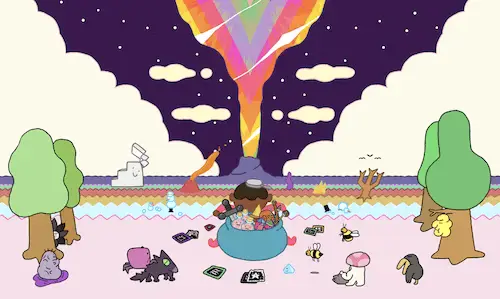If Zach Gage's aim was to make a unique, accessible, yet enticing and deep rouguelike game, he has more than succeeded. Card of Darkness is unlike any other roguelike I've played.
Stacks of cards are used to navigate through each floor of monsters the main character has to get through in order to defeat the boss of each environment. Ultimately, the goal is to find the Card of Darkness by defeating the final boss and saving the world, as any young hero randomly chosen by a frog should.
Hand-illustrated and animated by Pendleton Ward, the artist behind Adventure Time, the eight environments that our hero explores are vibrant, filled with different colors and nuances. The art and animations are lighthearted and lively, drawing attention to the diversity of landscapes. The monsters, and bosses look powerful and intimidating, yet silly and bright, all at once.
Cards of Strength, but Also Possibly Death
Each floor is a grid of card stacks assigned a number representing strength or value. The top of each card stack has either a monster, weapon, scroll, or gold and potions, but don't be fooled by the simplicity. Each monster has different abilities including, but not at all limited to, poison, confusion, and swapping locations with another card stack.
To combat these monsters, you can use weapons that have their own strengths and weaknesses, scrolls that can bestow a one-time use power — such as monster attack reduction or weapon summoning — and unique potions that give health boosts yet each come with different caveats. You can also buy scrolls in the little barrel store you'll find in parts of the land you explore.
You'll have to use all these items to your advantage to carve your path to the pile of ashes (or stairs if there are multiple floors), which is your only way out. But be wary that when you pick up a card from a stack, you'll have to pick up all the cards from that stack before being able to exit through the stairs.
If you pick up gold or weapons and a powerful monster lies underneath, you'll eventually have to pick up that monster card, potentially leading to your death, so be strategic about those pickups.
Swords or Fists of Fury?!
An important aspect of this game is the weapons. With the depth of this seemingly simple game, it is a given that weapons each have very different abilities. Some weapons, like slingshots, fittingly subtract one point of attack power on each use, while others are double edged swords that sting you back, or break on first contact.
Of course, there is also the most underrated weapon: your fists. However, their strength can only be increased with a special potion.
When using a weapon on a monster, it decreases how much their attack would affect you. For example, wielding a weapon with a value of six will mean a monster with a value of ten can only hurt your health by four points.
However, if you use a weapon where the parity of the number doesn't match the parity of the monster's number — say using a weapon with seven attack on a monster with eight — it will still cancel out the attack points to protect your health, but it'll break and be unusable.
Bare fists, however, are powerful. This is because they can't break — can't have a hero with a broken hand. However, the power is balanced out by the fact that you have to pick up a special potion in order to increase the strength of the fist.
Some weapons and playstyles have natural synergies with special power-up cards you obtain after beating a level or a boss. These synergies, in turn, work better in certain levels than others. For example, if you decide to mainly be a fist-fighter, you'll have a lot of trouble in a level where there are no fist-strength increasing potions.
When effectively utilizing the synergies, you can become nearly unbeatable by the time you reach the final boss. Just remain vigilant about the order in which you pick up card stacks and your use of the various potions on the floor of each dungeon.
Boss Battles
Boss battles are a bit different from the regular levels, where you pick up stacks of cards to clear a path towards the next floor of the dungeon or the exit. In boss battles, you have to clear card stacks until you find a heart at the bottom of the stack and destroy it.
The gameplay here is like an intricate minesweeper. Each boss has three hearts, and there are heart compass symbols directly adjacent to the current heart's location to help you find it.
I personally didn't find these any more challenging than the floors leading up to them. In fact, they were more relaxing as I didn't have to worry about clearing a path to the exit, but rather just clearing card stacks in whatever order my heart desired.
It's the Little Things
Though the art, game design, strategy, and items are the core of what makes the game so engaging and consuming, I think the nuances that make the game whole are just as important to mention. There are two in particular I'd like to touch on: journaling and haptic feedback.
Along the way, the hero writes journal entries, allowing you insight into his thoughts and feelings about his journey thus far. Most of them will make you chuckle, just as each boss' speeches will, while also giving you more context to the his story and adding that extra bit of substance to further absorb our attention.
To revisit his past journal entries, all you have to do is find his tiny character sitting on a rock in any previous landscape, scrawling into his notebook.
The other small, yet significant element I wanted to mention is haptic feedback. Haptic feedback upon picking up cards and defeating monsters no doubt elevated the already amazing card-flipping dungeon-crawling experience. Some games use this too much, and some don't use it at all, but I found that Card of Darkness used just the right amount. It made every card pickup and monster bash feel more satisfying. I only wish more mobile games utilized haptic feedback like this.
The Most Accessible Rougelike There Is
Here's what Zach Gage said on his page about his making of the game:
Over the past decade I've established a practice of making deep, compelling, and accessible games for people who don't have the time or space in their lives to learn every intricate detail of every videogame. ...Card of Darkness is my attempt to take some of my favorite moments from roguelike games, and distill them into a simple but deep card game.
I couldn't have described Card of Darkness better than that.
It had all the features of a roguelike, with random generation of dungeon floors and monster battles, the high quantity of items and loot, and the diversity of environments compressed into what felt like a simple strategy card game. The game was at once straightforward and undemanding while somehow managing to be layered with the same complexities of a fully-formed roguelike game.
If you love roguelikes, strategy games, card games, or want all three in one, I recommend this game. If you want to try roguelikes but don't have time to play a conventional one, I recommend this game. If you like to play games at all, I strongly recommend this game.
Let's end with another gem of a quote from Zach Gage describing Card of Darkness:
It's the streamlined design you'd expect from me, but this time layered with tons of stuff, just so much stuff!

